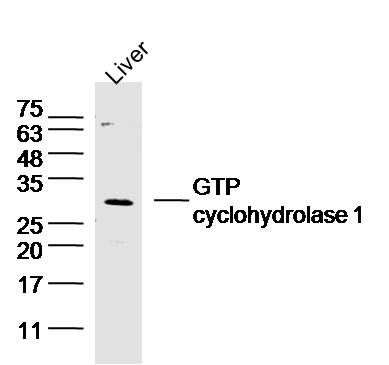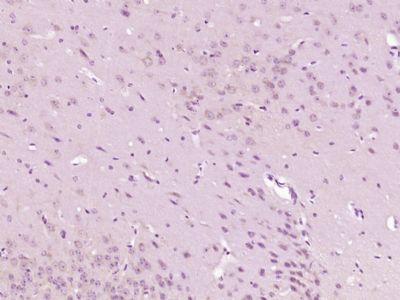GTP cyclohydrolase 1 Polyclonal Antibody
Purified Rabbit Polyclonal Antibody (Pab)
- 产品详情
- 实验流程
Application
| WB, IHC-P, IHC-F, IF, E |
|---|---|
| Primary Accession | P30793 |
| Reactivity | Rat |
| Host | Rabbit |
| Clonality | Polyclonal |
| Calculated MW | 27903 Da |
| Physical State | Liquid |
| Immunogen | KLH conjugated synthetic peptide derived from human GTP-CH-1 |
| Epitope Specificity | 34-110/250 |
| Isotype | IgG |
| Purity | affinity purified by Protein A |
| Buffer | 0.01M TBS (pH7.4) with 1% BSA, 0.02% Proclin300 and 50% Glycerol. |
| SUBCELLULAR LOCATION | Cytoplasm. Nucleus. |
| SIMILARITY | Belongs to the GTP cyclohydrolase I family. |
| Post-translational modifications | Phosphorylated by casein kinase II at Ser-81 in HAECs during oscillatory shear stress; phosphorylation at Ser-81 results in increased enzyme activity. |
| DISEASE | Defects in GCH1 are the cause of GTP cyclohydrolase 1 deficiency (GCH1D) [MIM:233910]; also known as atypical severe phenylketonuria due to GTP cyclohydrolase I deficiency;. GCH1D is one of the causes of malignant hyperphenylalaninemia due to tetrahydrobiopterin deficiency. It is also responsible for defective neurotransmission due to depletion of the neurotransmitters dopamine and serotonin. The principal symptoms include: psychomotor retardation, tonicity disorders, convulsions, drowsiness, irritability, abnormal movements, hyperthermia, hypersalivation, and difficulty swallowing. Some patients may present a phenotype of intermediate severity between severe hyperphenylalaninemia and mild dystonia type 5 (dystonia-parkinsonism with diurnal fluctuation). In this intermediate phenotype, there is marked motor delay, but no mental retardation and only minimal, if any, hyperphenylalaninemia. Defects in GCH1 are the cause of dystonia type 5 (DYT5) [MIM:128230]; also known as progressive dystonia with diurnal fluctuation, autosomal dominant Segawa syndrome or dystonia-parkinsonism with diurnal fluctuation. DYT5 is a DOPA-responsive dystonia. Dystonia is defined by the presence of sustained involuntary muscle contractions, often leading to abnormal postures. DYT5 typically presents in childhood with walking problems due to dystonia of the lower limbs and worsening of the dystonia towards the evening. It is characterized by postural and motor disturbances showing marked diurnal fluctuation. Torsion of the trunk is unusual. Symptoms are alleviated after sleep and aggravated by fatigue and excercise. There is a favorable response to L-DOPA without side effects. |
| Important Note | This product as supplied is intended for research use only, not for use in human, therapeutic or diagnostic applications. |
| Background Descriptions | GTP cyclohydrolase I (also designated dopa-responsive dystonia) catalyzes the conversion of GTP to D-erythro-7,8-dihydroneopterin triphosphate, the first and rate-limiting step in tetrahydrobiopterin (BH4) biosynthesis. Tetrahydrobiopterin is an essential cofactor for 3 aromatic amino acid monooxygenases: phenylalanine, tyrosine, and tryptophan hydroxylases. Animals can synthesize tetrahydrobiopterin in vivo from GTP through several enzymatic reactions. |
| Gene ID | 2643 |
|---|---|
| Other Names | GTP cyclohydrolase 1, 3.5.4.16, GTP cyclohydrolase I, GTP-CH-I, GCH1, DYT5, GCH |
| Target/Specificity | In epidermis, expressed predominantly in basal undifferentiated keratinocytes and in some but not all melanocytes (at protein level). |
| Dilution | WB=1:500-2000,IHC-P=1:100-500,IHC-F=1:100-500,IF=1:100-500,ELISA=1:5000-10000 |
| Format | 0.01M TBS(pH7.4) with 1% BSA, 0.09% (W/V) sodium azide and 50% Glyce |
| Storage | Store at -20 °C for one year. Avoid repeated freeze/thaw cycles. When reconstituted in sterile pH 7.4 0.01M PBS or diluent of antibody the antibody is stable for at least two weeks at 2-4 °C. |
| Name | GCH1 |
|---|---|
| Synonyms | DYT5, GCH |
| Function | Positively regulates nitric oxide synthesis in umbilical vein endothelial cells (HUVECs). May be involved in dopamine synthesis. May modify pain sensitivity and persistence. Isoform GCH-1 is the functional enzyme, the potential function of the enzymatically inactive isoforms remains unknown. |
| Cellular Location | Cytoplasm. Nucleus |
| Tissue Location | In epidermis, expressed predominantly in basal undifferentiated keratinocytes and in some but not all melanocytes (at protein level). |
Research Areas
For Research Use Only. Not For Use In Diagnostic Procedures.
Application Protocols
Provided below are standard protocols that you may find useful for product applications.
终于等到您。ABCEPTA(百远生物)抗体产品。
点击下方“我要评价 ”按钮提交您的反馈信息,您的反馈和评价是我们最宝贵的财富之一,
我们将在1-3个工作日内处理您的反馈信息。
如有疑问,联系:0512-88856768 tech-china@abcepta.com.
¥ 1,500.00
Cat# AP54184























 癌症的基本特征包括细胞增殖、血管生成、迁移、凋亡逃避机制和细胞永生等。找到癌症发生过程中这些通路的关键标记物和对应的抗体用于检测至关重要。
癌症的基本特征包括细胞增殖、血管生成、迁移、凋亡逃避机制和细胞永生等。找到癌症发生过程中这些通路的关键标记物和对应的抗体用于检测至关重要。 为您推荐一个泛素化位点预测神器——泛素化分析工具,可以为您的蛋白的泛素化位点作出预测和评分。
为您推荐一个泛素化位点预测神器——泛素化分析工具,可以为您的蛋白的泛素化位点作出预测和评分。 细胞自噬受体图形绘图工具为你的蛋白的细胞受体结合位点作出预测和评分,识别结合到自噬通路中的蛋白是非常重要的,便于让我们理解自噬在正常生理、病理过程中的作用,如发育、细胞分化、神经退化性疾病、压力条件下、感染和癌症。
细胞自噬受体图形绘图工具为你的蛋白的细胞受体结合位点作出预测和评分,识别结合到自噬通路中的蛋白是非常重要的,便于让我们理解自噬在正常生理、病理过程中的作用,如发育、细胞分化、神经退化性疾病、压力条件下、感染和癌症。







